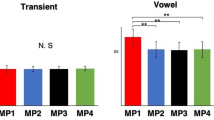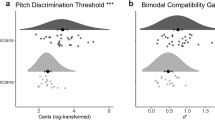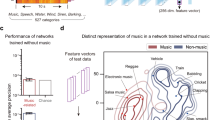Abstract
Acoustic stimuli are processed throughout the auditory projection pathway, including the neocortex, by neurons that are aggregated into ‘tonotopic’ maps according to their specific frequency tunings1,2,3. Research on animals has shown that tonotopic representations are not statically fixed in the adult organism but can reorganize after damage to the cochlea4 or after training the intact subject to discriminate between auditory stimuli5. Here we used functional magnetic source imaging (single dipole model) to measure cortical representations in highly skilled musicians. Dipole moments for piano tones, but not for pure tones of similar fundamental frequency (matched in loudness), were found to be enlarged by about 25% in musicians compared with control subjects who had never played an instrument. Enlargement was correlated with the age at which musicians began to practise and did not differ between musicians with absolute or relative pitch. These results, when interpreted with evidence for modified somatosensory representations of the fingering digits in skilled violinists6, suggest that use-dependent functional reorganization extends across the sensory cortices to reflect the pattern of sensory input processed by the subject during development of musical skill.
This is a preview of subscription content, access via your institution
Access options
Subscribe to this journal
Receive 51 print issues and online access
$199.00 per year
only $3.90 per issue
Buy this article
- Purchase on Springer Link
- Instant access to full article PDF
Prices may be subject to local taxes which are calculated during checkout


Similar content being viewed by others
References
Merzenich, M. M., Knight, P. L. & Roth, G. L. Cochleotopic organization of primary auditory cortex in the cat. Brain Res. 63, 343–346 (1973).
Merzenich, M. M., Kaas, J. H. & Roth, G. L. Comparison of tonotopic maps in animals. J. Comp. Neurol. 166, 387–402 (1976).
Rauschecker, J. P., Tian, B. & Hauser, M. Processing of complex sounds in the macaque nonprimary auditory cortex. Science 268, 111–114 (1995).
Irvine, D. R. F. & Rajan, R. Advances in Hearing Research (eds Manley, G. A., Klump, G. M., Kappl, C., Fastl, M. & Oeckinghaus, H.) 3–23 (World Sci Publ Co, Singapore, 1995).
Recanzone, G. H., Schreiner, C. E. & Merzenich, M. M. Plasticity in the frequency representation of primary auditory cortex following discrimination training in adult owl monkeys. J. Neurosci. 13, 87–103 (1993).
Elbert, T., Pantev, C., Wienbruch, C., Rockstroh, B. & Taub, E. Increased cortical representation of the fingers of the left hand in string players. Science 270, 305–307 (1996).
Pantev, C. et al. Tonotopic organization of the human auditory cortex revealed by transient auditory evoked magnetic fields. Electroencephalogr. Clin. Neurophysiol. 69, 160–170 (1988).
Schlaug, G., Jancke, L., Huang, Y. & Steinmetz, H. In vivo evidence of structural brain asymmetry in musicians. Science 267, 699–701 (1995).
Yakovlev, P. I. & Lecours, A. in Regional Development of the Brain in Early Life (ed. Minkowski, A.) 3–70 (Blackwell, Oxford, 1967).
Takeuchi, A. H. & Hulse, S. H. Absolute pitch. Psychol. Bull. 113, 345–361 (1993).
Barnea, A., Granot, R. & Pratt, H. Absolute pitch-electrophysiological evidence. Int. J. Psychophysiol. 16, 29–38 (1994).
Benguerel, A. P. & Westdal, C. Absolute pitch and the perception of sequential music intervals. Music Percept. 9, 105–120 (1991).
Williamson, S. J. & Kaufman, L. in Auditory Evoked Magnetic Fields and Electric Potentials (eds Grandori, F., Hoke, M. & Romani, G. L.) 1–39 (Karger, Basel, 1990).
Kaas, J. H., Merzenich, M. M. & Killackey, H. P. The reorganization of somatosensory cortex following peripheral nerve damage in adult and developing mammals. Annu. Rev. Neurosci. 6, 325–356 (1983).
Acknowledgements
We thank our subjects for their cooperation, K. Berning for assistance and A.Wollbrink for engineering. This research was supported by grants from the Deutsche Forschungsgemeinschaft and NATO.
Author information
Authors and Affiliations
Corresponding author
Rights and permissions
About this article
Cite this article
Pantev, C., Oostenveld, R., Engelien, A. et al. Increased auditory cortical representation in musicians. Nature 392, 811–814 (1998). https://doi.org/10.1038/33918
Received:
Accepted:
Published:
Issue Date:
DOI: https://doi.org/10.1038/33918
This article is cited by
-
Causal associations between sleep traits and brain structure: a bidirectional Mendelian randomization study
Behavioral and Brain Functions (2023)
-
Enduring musician advantage among former musicians in prosodic pitch perception
Scientific Reports (2023)
-
Psychoacoustic Similarity Judgments in Expert Rappers and Laypersons
Journal of Psycholinguistic Research (2023)
-
Multisensory interactions on auditory and somatosensory information in expert pianists
Scientific Reports (2022)
-
Brain oscillation recordings of the audience in a live concert-like setting
Cognitive Processing (2022)
Comments
By submitting a comment you agree to abide by our Terms and Community Guidelines. If you find something abusive or that does not comply with our terms or guidelines please flag it as inappropriate.



